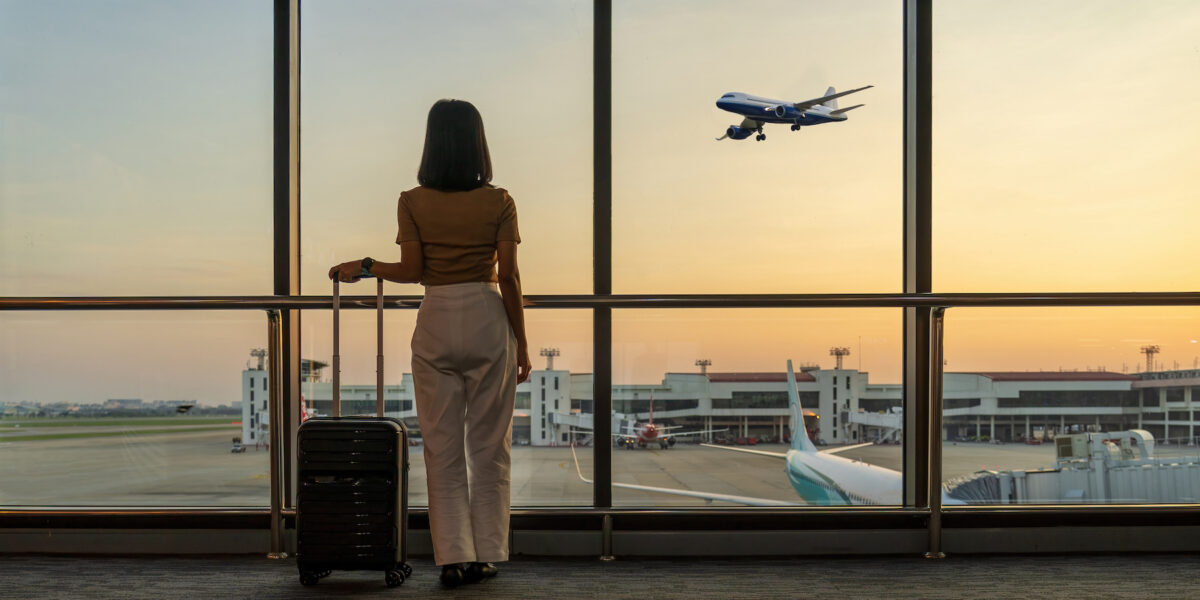
Flying Has Never Been More Stressful. These Tools Will Help You Combat In-Flight Anxiety.
Use these practices to help alleviate stress while flying.

Getty Images
Regardless of the daily news cycle, it can be anxiety-inducing to fly. And while it may seem that there’s an overwhelming number of plane incidents these days, air travel is still one of the safest (and sometimes the only) way to get around. Thankfully, there are techniques to help mitigate the stress.
“The key to reducing travel anxiety isn’t about finding the perfect in-the-moment technique—it’s about conditioning your nervous system ahead of time so you don’t default to fight-or-flight when stress hits,” says Megan Moseley, PT and Founder of Bodywise Consulting & Coaching.

Courtesy Visit Tuscon
Moseley teaches these techniques to clients, as well as at the Touch Grass wellness retreats at Brasada Ranch in Central Oregon, where programming focuses on cultivating a sense of centeredness—all with the backdrop of the snow-capped Cascade Mountains in the high desert.
These two-minute practices, done three to five times a day, can regulate your nervous system long before you even set foot in an airport, gradually rewiring your baseline stress response and making calm your new normal. It may sound complicated, but the strategies like breathwork, movement, and vagus nerve stimulation are actually quite simple.
These small daily actions ultimately enhance neuroplasticity, strengthen vagus nerve activation to improve emotional regulation, help discharge stored tension, and prevent the buildup of chronic stress. They also lower cortisol levels, reducing stress before it has a chance to accumulate, ensuring that your body is prepared to handle travel with greater ease and resilience.
“It’s about rewiring your relationship with flying at the nervous system level, dissolving old fear-based narratives, and inviting a new experience of safety, ease, and trust in yourself,” she says. Here are her tips to get you through your next flight.
Box Breathing
Box breathing in a count of inhaling for four seconds, holding at the top of the breath for four seconds, exhaling for four seconds, then holding at the bottom of the breath for four seconds, is a wonderful way to slow the heart rate and stabilize the nervous system and bring the mind into the present.
Orienting Exercises
Take a look around and name three neutral or pleasant things to signal safety. This helps redirect attention instead of getting caught in a negative thought spiral. As mammals we naturally want to orient ourselves in space, so this creates a sense of security.
Butterfly Hug or Tapping
A butterfly hug is a self-soothing technique where you cross your arms over the chest and gently tap the upper arms or chest alternately, mimicking the fluttering motion of a butterfly’s wings. It’s commonly associated with Eye Movement Desensitization and Reprocessing (EMDR) therapy, and is a great tool for the jitters. Light tapping on your arms or collarbones also down-regulates stress.
Foot-to-Floor Connection
Pressing feet into the ground and focusing on making contact at all four corners creates stability and support, and brings the body into the present.
Ambient Music
“Certain frequencies and sound patterns have been shown to help the brain transition into states of relaxation, alertness, or deep rest. Solfeggio frequencies are ancient tones, such as 396 Hz, 528 Hz, and 741 Hz, believed to support healing, ease anxiety, and promote overall well-being,” she continues. “Binaural beats work by playing two slightly different frequencies in each ear, which the brain then combines into a third tone, guiding it into relaxed (alpha), meditative (theta), or deep sleep (delta) states. Another approach is isochronic tones—repetitive beats that help synchronize brainwaves without the need for headphones, making them a convenient way to calm the mind while traveling.”
Instrumental music and nature sounds like ocean waves, rainfall, or forest soundscapes can also be grounding. Instrumental and classical music, such as soft piano, slow jazz, or lo-fi beats can help soothe the mind. Another effective approach is slow rhythmic drumming, which mimics the steady beat of a heart, supporting nervous system regulation and creating a sense of stability.
Reading Wisely
“Sometimes, the best way to regulate is to shift focus—not by avoiding, but by engaging in something that feels good,” says Moseley. Instead of avoiding the anxiety, shift focus to something else, like curiosity. She suggests books that offer a sense of wonder, perspective, and connection to something bigger: Awe: The New Science of Everyday Wonder and How It Can Transform Your Life by Dacher Keltner; An Immense World: How Animal Senses Reveal the Hidden Realms Around Us by Ed Yong; and The Untethered Soul by Michael A. Singer. Any book that draws you in and allows you to just “be” in the present will do the trick.
Peaceful Podcasts
“Just like books, the best podcasts for travel anxiety aren’t necessarily the ones that ‘fix’ stress but the ones that engage, inspire, and ground you in presence,” says Moseley. “Whether it’s thoughtful conversations, fascinating science, or immersive storytelling, the key is finding what genuinely captures your attention and soothes your nervous system.”
Some of her favorites include On Being with Krista Tippett, Where Should We Begin? with Esther Perel, Ologies, and This American Life.
We only recommend things we love. If you buy something through our site, we might earn a commission.
